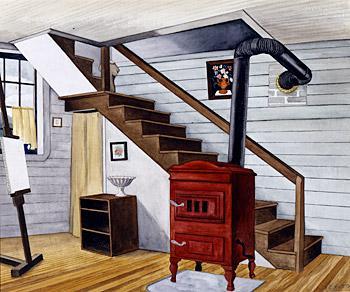
George Ault, Studio Interior, 1938, Watercolor and pencil on paper, Smithsonian American Art Museum, Transfer from The Museum of Modern Art
"Welcome to the disquieting, and I may say, disturbing world of George Ault," independent historian Stephen May told us at the beginning of his lecture on the painter who is the subject of the exhibition To Make a World: George Ault and 1940s America, currently on view at the museum. "Few artists have had a sadder life, personal troubles, family troubles, as well as a world in chaos." In spite of all the difficulties, May told us, and illustrated in an informative series of images, Ault focused on order: precision, straight lines, and for the artist, paintings populated with roofs, clouds, and telephone lines, but very few people.
Though there was only one George Ault, it seems he went through many different artistic stages throughout his short life. May succeeded in showing us the Ault that existed before the 1940s, the subject of the exhibition on view, and gave examples of unexpected abstract expressionist-esque works he experimented with near the end of his life. Born into privilege in 1891, Ault and his family moved from Cleveland to England when he was nine years old. The first works we were shown were watercolors and paintings done when Ault was twenty-five years old, in what May called an "Anglicized Impressionism." They barely resemble the moody nightscapes of Russell's Corners, Woodstock, that form the heart of the show at American Art. When he moved to New York and settled in Greenwich Village, his works became darker. By this time his family was plagued by personal loss in the suicides of three of his siblings as well as the family's financial meltdown in the crash of 1929. And so the Ault of this period, with a penchant for painting roofs and cityscapes mostly devoid of people and windows that are painted black, was "a depressed alcoholic who alienated dealers and artist friends and became much more of a loner." Some of his city pieces from this period are just stunning, such as his renderings of the New York skyline as well as depictions of Sullivan Street and Hudson Street in the Village. They hold up to similar scenes painted by Georgia O'Keeffe and Edward Hopper. "Ault did not paint the illustrious skyscrapers but the tenements and warehouses," May told us.
Fed up with the city, he and Louise Jonas, the woman who would become his wife and who tried to boost his career after his death, moved to Woodstock, New York. Many of the paintings done at this time can be viewed in the exhibition: more lonely roads, stunted trees, interesting clouds, and telephone wires that seem to fade into the ether. What was he trying to say about communication? What was he trying to tell us? "You can't pigeonhole him," May told us at the end of his talk, "He left us a wonderful legacy of finely crafted and thought-provoking work."

